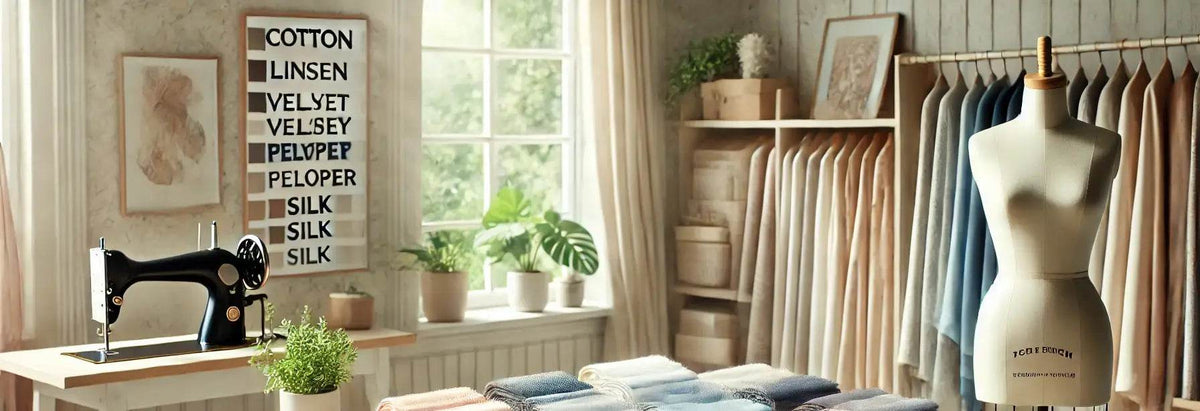Understanding Fabric Types for Your Sewing Projects
Understanding Fabric Types for Your Sewing Projects
When I first started sewing, I thought all fabric was just... fabric. I judged by color, maybe touch if I was feeling adventurous. That was before I accidentally used a stretchy jersey for a structured tote bag. Let’s just say it had character. Understanding fabric types isn’t just for fashion school grads—it’s survival for anyone who wants their project to not collapse, stretch like a hammock, or shrink into oblivion. Here's everything I wish someone had whispered gently to me before I stitched my first disaster.

Woven vs. Knit Fabrics
I once tried to turn a jersey knit into a pair of tailored trousers. The result? A sad, wobbly pair of leggings that looked like they gave up halfway down the inseam.
Woven fabrics are created on a loom with threads running at right angles. Think cotton poplin, denim, and linen. They don’t stretch unless they’ve been genetically modified by Lycra. Knits, on the other hand, are made from looping yarns. Jersey, interlock, rib—these babies stretch and recover, making them great for comfy clothes, but tricky for structured seams unless you stabilize them.
Pro tip: If the fabric frays when you cut it, it’s woven. If it curls at the edges and bounces like a caffeinated toddler, it’s knit.
Common Fabric Types and Their Uses
- Solid Cotton: The best friend of beginners. No stretch, easy to handle, and totally predictable (unlike your seam allowances).
- Printed Cotton: Same as above, but with more personality. Just don’t forget to pattern-match if the design is bold—or embrace chaos, I won’t judge.
- Wool: The cozy classic. Great for coats and structured pieces. Requires dry cleaning and a respectful attitude.
- Fleece: Soft, snuggly, stretchy. Will fill your sewing space with fuzz. Excellent for hoodies, chaos for tiny seams.
- Corduroy: Textured with attitude. Direction matters—cut it wrong, and your jacket panels will shimmer like disco tiles.
- Knit Fabric: For T-shirts, dresses, tears of joy and frustration. Use ballpoint needles and stretchy stitches, or prepare for skipped seams and sorrow.
- Silk: A diva. Beautiful, luxurious, slippery as guilt. Requires delicate handling and zero coffee nearby.

Understanding Fabric Nap
I once cut one sleeve of a corduroy jacket against the nap. I looked like I was being lit from one side… permanently. Learn from my shimmer shame.
Nap refers to the direction of the raised fibers on a fabric’s surface. It affects how light reflects on the material—think velvet, suede, or corduroy. Brush your hand down the fabric and it’ll feel smooth one way, rough the other. You must cut all pattern pieces facing the same direction, or risk tonal mismatches that scream "homemade"—and not in the good way.
Pro tip: Add extra fabric to your pattern layout when working with nap. Trust me, mirror-cutting is only fun with snowflakes, not sleeves.
How to Choose the Right Fabric for Your Project
Let’s be honest: choosing fabric can feel like speed dating with 500 swatches. So how do you know who to take home? Start by asking what the fabric needs to do—stretch, drape, insulate, hold shape? Match that to your project. Don’t make a tailored coat out of jersey. Don’t make pajamas out of burlap. (Unless it’s a Halloween costume. Maybe.)
Look for: fiber content, weave, stretch, weight, and care instructions. Bonus points for pet-friendliness if you’ve got curious cats who think your fabric is their new bed.
Final Thoughts
Fabric isn’t just background material—it’s the co-star of every sewing project. Choosing the right one transforms your sewing from "meh" to "magnifique." Learn its quirks, test it, treat it with the love and starch it deserves. Your future self—draped in a handmade masterpiece that fits and flows—will thank you.



